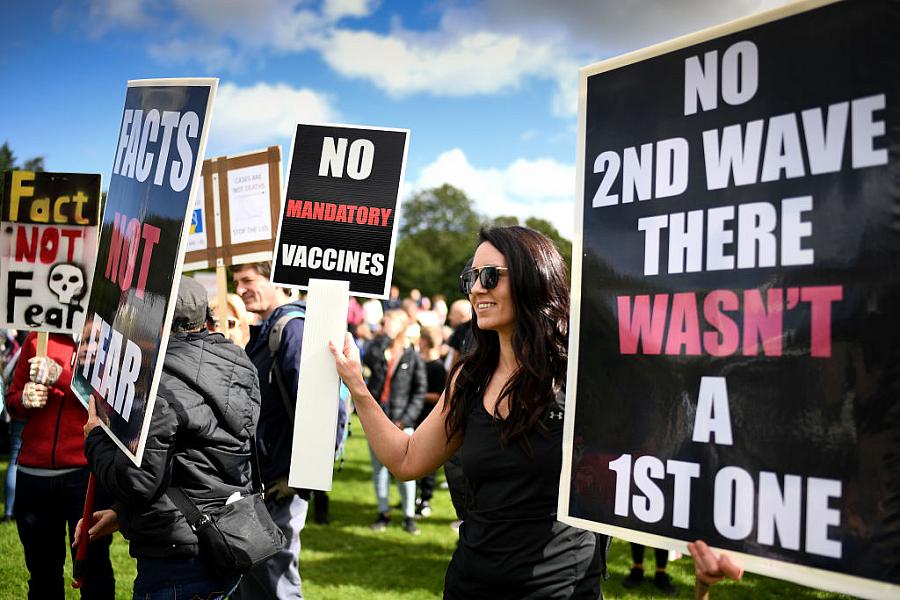To stop the pandemic, we need to fight the infodemic at the same time

(Photo by Jeff J Mitchell/Getty Images)
I was on a call recently the other day talking about the COVID-19 pandemic with researchers, public health officials, and health care leaders. Someone raised the idea of the “infodemic.” I pounced on it.
We have spent billions of dollars and millions of person-hours collectively around the world responding to the disease but very little time and money going after the virus that is disinformation. As the World Health Organization put it in a statement in September 2020:
The Coronavirus disease (COVID-19) is the first pandemic in history in which technology and social media are being used on a massive scale to keep people safe, informed, productive and connected. At the same time, the technology we rely on to keep connected and informed is enabling and amplifying an infodemic that continues to undermine the global response and jeopardizes measures to control the pandemic.
This has been true from the very early days of the outbreak. There have been — and continue to be — attempts to deny the very existence of the disease. There have been campaigns against social distancing, against mask wearing, against crowd-size control, and now against the very vaccines that promise to restore a sense of normalcy to our lives again.
On the call, I suggested we should go after the sources of disinformation the same way we have gone after the source of the virus. Who is creating the lie? Who is funding the lie? Who is spreading the lie?
Now, this was a polite crowd, and so I could tell that my bold talk made people a little uncomfortable. No mystery there. It’s one thing to go after a non-sentient virus, quite another to go after people who are neighbors, friends, politicians, religious leaders, business owners, and the like. I get it. It’s not fun to name and shame, and I’m not even sure that will work. What I think would be more effective is to expose the disinformation for what it is by explaining how it came to be, how it “went viral,” and who it appears to be benefiting.
So, I put the same challenge to journalists everywhere. You have done an incredible job making sense of the pandemic for people and helping explain concepts that most people never had to think about before. Here are three things to consider as you try to fight the infodemic with the same clarity and sense of purpose.
1) Disinformation is not just talk. These are focused efforts to spread incorrect information and they have real effects. They weaken the already fragile public health system, threatening people’s health and leading to more infections and deaths from the virus. People feel stigmatized in their communities for doing the right thing, such as wearing a mask or getting a vaccine. People fail to follow through on basic public health recommendations. That makes efforts like social distancing, masks, and vaccines less effective and drags out the pandemic. As the WHO put it starkly, “Misinformation costs lives. Without the appropriate trust and correct information, diagnostic tests go unused, immunization campaigns (or campaigns to promote effective vaccines) will not meet their targets, and the virus will continue to thrive.”
2) Disinformation demands action. One of the stories you can pursue is just what action is being taken — or what blind eye is being turned. Local, state, and national authorities need to have a plan to combat disinformation. What is the plan? They also need to work together. Are they coordinating? This includes their efforts to present accurate, science-based information in a timely and compelling way. Here in Washington state, we see frequent advertisements about how vaccines work, for example.
3) Disinformation does not follow party lines. This is a global pandemic, and so we should not fall into the lazy trap of thinking that the disinformation merely follows some traditional Republican vs. Democrat breakdown. It doesn’t. One of the most dismaying things I saw early in the pandemic were posts on Facebook by people I grew up with parroting rhetoric from the “Flatten the Fear” disinformation campaign. This was one of the early disinformation storylines, meant to appeal to people who thought of themselves as critical thinkers. The people posting were Republicans, Democrats, and Independents. They were people who had been spun. Recognize that the source of some of this disinformation is outside of the U.S. entirely. The New York Times reported in July how Russian government operatives were using disinformation on the pandemic to create confusion within the U.S. electorate. “Russian military intelligence, known as the G.R.U., has used its ties with a Russian government information center, InfoRos, and other websites to push out English-language disinformation and propaganda about the pandemic, such as amplifying false Chinese arguments that the virus was created by the United States military,” wrote reporters Julian E. Barnes and David E. Sanger.
My appeal is simple: Do your part to prevent the spread of disinformation by calling out the sources and the spreaders. We can make a difference, the same way we have made a difference in mobilizing collective action to stop the spread of the disease itself.

